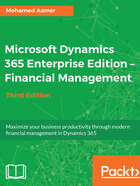
Understanding shared financial data
Since the previous version of Microsoft Dynamics 365 for Finance and Operations, Microsoft has introduced a new concept called shared financial data, which reduces the effort and time of deployment in a multiple-company environment and operational maintenance. A group of companies can share the same chart of accounts, currencies, and dimensions—this decreases the operation time. For example, a new main account will be available to all companies. The following figure explains the concept of shared financial data in detail:

The financial data that will be shared between the companies is as follows:
- Chart of accounts (COA): This contains the main account, the COA could be one shared COA between all legal entities, or a COA for one legal entity or group of legal entities. This is all dependent on customer requirements, and the nature of the business. It is a trade-off decision, if subsidiaries decide to maintain separate chart of accounts instead of using one shared COA.
- Account structure: This contains the applicable dimensions of the main accounts. This could be shared across legal entities, a group of legal entities or a single account structure to a single legal entity.
- Fiscal year: This contains the start date and end date of the fiscal year and the period's management. If all legal entities have the same fiscal year requirement, it is recommended you use the shared fiscal year between all legal entities.
- Currencies: This represents the default currency and reporting currency.
- Exchange rate type: This sets the monthly exchange rate for foreign currencies and the default budget exchange rate.
To access the ledger window, navigate to General ledger | Ledger setup | Ledger. The following screenshot shows the Microsoft Dynamics 365 for Finance and Operations ledger:

For the customer who will use a shared COA for all legal entities, and each legal entity has internal requirements for the main account, Microsoft Dynamics 365 for Finance and Operations gives you the ability to do an override on the main accounts per each legal entity. In the next section, we will walk-through the legal entity override options for the main accounts. To access the legal entity overrides, go to General ledger | Chart of accounts | Accounts | Main accounts, then move to the Legal entity overrides fast tab. The following screenshot shows the available override options. The override could be the suspension of a particular main account, an activate date, allocation terms, and an exchange rate type:

The following screenshot illustrates the financial dimension override per legal entity. This gives the option to specify the default dimensions, for an account; to access the default financial dimensions go to General ledger | Chart of accounts | Accounts | Main accounts, then move to the Legal entity overrides fast tab. After adding a legal entity, go to Default dimensions.

Enterprises may have subsidiaries in many countries that use shared COA. In such a scenario, you can use the multi-language capabilities in Microsoft Dynamics 365 for Finance and Operations. This enables the translation of the client interface, including menus and data translation.
In this section, we will focus on the translation of the shared COA functionality; this enables the translation of the client interface, including menus and data translation.
In my example, a company has two subsidiaries in one instance. The first legal entity is in the USA, and the second is in Italy. The COA is identical across legal entities, and each legal entity is required to have the COA in their own language:

The following example will demonstrate how to use the multi-language functionality in Dynamics 365 to fulfill the scenario presented previously. In order to fulfill these requirements and demonstrate it in a proper way:
- Firstly, use the shared COAs across legal entities (USA and Italy). The shared COA language is English.
- Secondly, use the translation functionality in the COA.
- Thirdly, add another user to set the language interface.
The following diagram illustrates the basic concept of the shared COA, the use of translation functionality, and user language:

The following screenshot illustrates the main account translation option; to access this form, go to General ledger | Chart of accounts | Accounts | Main account, then select your main account (110180 is used in this example). Select the Name Translations button:

In the Text translations form, select the language and add the translation text:

Go to System administration | Users | Users, then select User and move to User options, and move to Preferences under Options. Then move to the Language and country/region preferences fast tab and change the language to IT (Italian):

Changing the user options will result in menus being translated into Italian. To see this change, go to General ledger | Journal entries | General journal. Create and post a general journal entry from the Italian interface. Note the account name is shown in Italian:

The posted transaction details are shown in Italian, as shown here:

The following example shows what the translation looks like on a ledger transaction report (General ledger | Journal entries | General journals). Select the posted journal and go to Lines, then select Print and select Voucher:

The translations that you create are displayed everywhere that a main account name is displayed, except on the main account list.
The following screenshot demonstrates the multi-language functionality with the Trial Balance page. To access this page, go to General ledger | Inquiry and reports | Trial balance:
